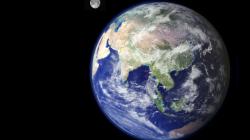Earth’s place in space addresses AC Science Understanding ACSSU078 The Earth is part of a system of planets orbiting around a star (the sun), through the context of thinking like an astronomer to seek out visible signs that prove the relative positions of the sun, Earth and moon.
Explore our new sequences for Year 5 aligned to AC V9
Earth’s place in space provides students with hands-on opportunities to:
- observe and describe the movement of the moon across the sky
- explore and model different theories about the movements of the sun, Earth and moon
- interpret their model in reference to personal and scientific observations
Students apply their new learning by:
- analysing data about the solar system to create a 3D scaled model of the solar system
Linking science with literacy
In the Primary Connections approach, students are supported to create representations that draw on and strengthen their literacy development. In Earth’s place in space, students represent and explain their understanding about how the Earth is part of a system of planets orbiting around a star (the sun), by creating these representations:
- Factual recount
- Flow chart
- Glossary
- Procedural text
- Role play
- Data table
- TWLH chart
- Word wall
This is a classic Primary Connections sequence aligned with the Australian Curriculum V8.4. It is only available as a downloadable package.
The Earth’s place in space sequence package includes all the resources you need to teach this sequence, including:
- The Earth’s place in space unit PDF
- Equipment list
- Australian Curriculum v8.4 alignment
- Student eResource sheets
- Assessment resources:
- Assessment rubrics
- Work samples
- Student self-assessment
- Achievement standard class checklist
Teacher tools
Our new all-online sequence Space innovators shares a curriculum content descriptor with this sequence. Space innovators is aligned to the Australian Curriculum V9 and contains embedded professional learning and supplementary teacher advice.
Space innovators
Students use scientific models to explore phenomena on Earth involving the relative position of the Sun and Moon, such as day and night, variable day length and the phases of the Moon. They explore the wider solar system and consider the scientific and technological innovations that have enabled humans to study space.

